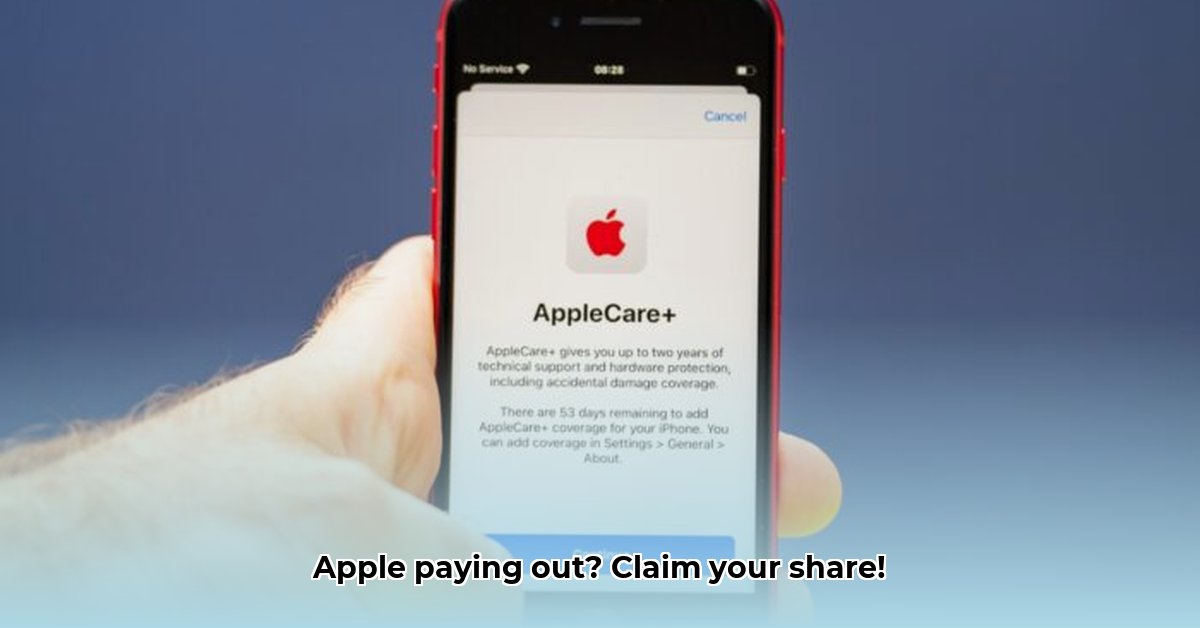“`markdown
Apple Replacement Device Lawsuit: Get Your Settlement
Did you receive a refurbished iPhone or iPad as a replacement under your AppleCare+ warranty? You might be entitled to compensation. Several class-action lawsuits have targeted Apple’s practice of using refurbished devices as replacements, arguing that this violates the terms of their warranty agreements. This article breaks down the details of these lawsuits, what they mean for consumers, and what you can do if you were affected. Learn about your consumer rights and how to protect yourself in the future. For more on tech lawsuits, see this helpful resource: Celcius Lawsuit.
Apple Replacement Claims: Unveiling Device Settlement Insights
Apple’s reputation for quality and innovation faced scrutiny when lawsuits emerged challenging their replacement device practices under AppleCare+. Consumers alleged that replacements were not “new or equivalent” as promised, but rather refurbished. These legal battles have led to settlements, policy revisions, and raised important questions about warranty transparency.
The AppleCare+ Promise: A Deeper Dive
AppleCare+ is a premium warranty plan designed to offer peace of mind, providing “new or equivalent” replacements. However, the definition of “equivalent” became a major point of contention. Did it mean a brand-new device, as many consumers assumed, or a rigorously tested refurbished one? The ambiguity sparked frustration and legal action. Were consumer expectations aligned with Apple’s interpretation of the warranty?
Key Lawsuits: Maldonado v. Apple, Inc. and the Battle for Consumer Rights
Class-action lawsuits, including Maldonado v. Apple, Inc., challenged Apple’s repair practices head-on. Representing thousands of customers, these lawsuits focused on the discrepancy between Apple’s promise and the reality of receiving refurbished devices. Plaintiffs argued breach of contract and violations of consumer protection laws, while Apple maintained that refurbished devices met their quality standards. The ensuing legal battles resulted in substantial financial settlements, highlighting the power of collective action and the importance of clear warranty terms.
Millions in Settlements: Are You Owed?
The lawsuits resulted in millions of dollars distributed to affected customers. A settlement in 2022 saw Apple agree to pay $95 million to customers who received refurbished replacements. While the initial wave of settlement checks saw a low redemption rate, a second round of payments was issued to those who had cashed their first checks, indicating remaining funds from unredeemed payments.[^1] This process underscores the importance of staying informed about class-action settlements and claiming what you are entitled to. If you believe you are eligible, it is important to check with the settlement administrator. Did you receive a check? It might still be worth cashing!
The Core Issue: Defining “New or Equivalent” Device
The heart of the matter lies in interpreting “new or equivalent.” Apple argued their refurbished devices met quality standards through rigorous testing and certification. Consumers felt entitled to a brand-new device, or at least a clear and upfront notification of the potential to receive a refurbished one. Courts seemed to acknowledge the validity of the customers’ perspective, emphasizing the need for transparent communication regarding warranty terms. The difference in perception fueled these lawsuits.
The Aftermath: Damage Control for Apple and Brand Reputation
These lawsuits undoubtedly impacted Apple’s reputation for quality and customer satisfaction. While Apple didn’t admit wrongdoing, the settlements and associated publicity likely damaged their brand image and potentially eroded user loyalty. Trust is paramount in the tech industry, and these legal battles raised concerns about Apple’s commitment to its customers. It remains to be seen whether Apple’s reputation will fully recover, and what long-term effects these lawsuits will have on consumer perception.
Protecting Yourself: What Consumers Can Do Now
Learning from these lawsuits, here’s how to protect yourself in similar situations:
- Scrutinize Device Warranties: Read the fine print carefully before purchasing extended warranties on any electronic device. Pay close attention to replacement terms, specifically the definition of “new or equivalent.” Assume nothing, ask questions, and seek clarification on any ambiguities.
- Meticulously Document Replacement Device: If you receive a replacement, document its condition in detail with photos and videos immediately upon receipt, noting any imperfections, cosmetic damage, or signs of prior use. Retain all communication with the company regarding the replacement. This serves as evidence in case of disputes.
- Understand Consumer Rights: Familiarize yourself with consumer protection laws in your area, particularly those related to warranties and deceptive trade practices. Knowing your rights can help navigate disputes and pursue legal action if necessary.
- Consider Collective Action: If a company violates its warranty promises and you are not alone, consider joining a class-action lawsuit. This can provide significant leverage and resources to pursue your claims.
- Review AppleCare+ Documentation: Obtain and carefully review the official AppleCare+ terms and conditions for your specific device and purchase date. These documents outline the specific coverage, limitations, and replacement policies in detail.
- Check Device Serial Numbers: When receiving a replacement device, verify its serial number and research its origin. This may provide information about whether the device is new or refurbished.
- Communicate with Apple Support: If you receive a replacement that you believe does not meet the warranty terms, immediately contact Apple Support to voice your concerns and seek clarification or resolution. Document all interactions.
Apple’s Response: Has Apple Improved Transparency in Device Warranties?
Following the lawsuits and settlements, Apple has likely updated its warranty language and replacement policies to provide greater clarity and transparency. While Apple has maintained a low profile regarding the specifics of these legal actions, the company may have taken steps to address consumer concerns and prevent future disputes. It is advisable to carefully review the current AppleCare+ terms and conditions for specific devices to assess whether improvements in transparency have been implemented. Experts predict a broader industry shift towards greater transparency in warranty descriptions, setting a new normal involving other tech companies.
The Long-Term Picture: Lessons Learned in Apple Replacement Device Policies
The Apple replacement device lawsuit saga underscores the need for clear and honest communication between companies and consumers regarding warranty policies and replacement practices. Manufacturers must ensure that their warranty language accurately reflects the condition of replacement products, and consumers should be diligent in reviewing warranty terms and documenting any issues that arise. The lawsuits demonstrate the power of collective legal action and holding businesses accountable for their promises.
How to Determine if my AppleCare+ Replacement iPhone is Truly Equivalent to New?
Key Takeaways:
- Refurbished Devices: Apple’s use of refurbished devices as AppleCare+ replacements led to class-action lawsuits.
- Mislead Device Expectations: Consumers felt replacement devices didn’t meet the expectations of “new or equivalent.”
- Device Settlement Significance: Significant settlements resulted from these lawsuits, impacting Apple’s reputation.
- Warranty Guidance: Consumers should thoroughly review warranty terms and understand their rights.
- Device Communication: Apple may need to improve warranty clarity and communication with customers.
Gaining Clarity: AppleCare+ and its Promises, Device Misconceptions
AppleCare+ promises peace of mind. You pay extra for repairs and replacements. A central question in the lawsuit: How to determine if my AppleCare+ replacement iPhone is truly equivalent to new? Is it even possible to make that determination without specialized knowledge or equipment?
The Lawsuits: A Battle Over “Equivalent” Device Criteria
Multiple lawsuits exploded. Consumers claimed Apple deceptively provided refurbished iPhones as “new or equivalent” replacements. The ambiguous meaning of “equivalent to new” was the core issue. Resulting in millions of dollars in settlements, lawsuits like Maldonado v. Apple exposed consumer rights concerns.
The Discrepancy: Device Expectations vs. Reality in Apple Replacement Claims
The lawsuits highlighted the gap between the iPhone maker’s claims that the replacements were “equivalent”, and consumers receiving phones with visible imperfections, cosmetic damage, or performance issues. Was this a fair representation of Apple’s commitment involving device warranties? How can consumers reconcile the marketing promises with the actual experience?
Examining Apple’s Device Replacement Practices: What Went Wrong?
Apple’s replacement process became a point of contention. This fueled the debate: What does “equivalent to new” actually mean regarding claims to device replacements? The lack of communication exacerbated the issue.
Device Aftermath and Settlements: Consumer Trust in Apple
The settlements involved substantial sums. Apple faced criticism. The impact extended beyond finances; consumer trust eroded as it had raised questions in relations around device replacements. The long-term ramifications for brand loyalty are significant.
Consumer Actions: Protecting Yourself From Replacement Device Claim Issues
What actions can you take? First, carefully scrutinize your AppleCare+ terms to understand which devices are insured and the specific replacement policies. Secondly, thoroughly document any issues throughout the whole process concerning device replacements. Request written confirmation of the replacement device’s condition and warranty status.
Apple’s Response and Device Policy Changes: Transparency and Responsiveness
Apple may have adjusted its policies given claims device discrepancies, after which clear communication remains crucial. Proactive measures restore relationships between consumers and device insurance.
Improving Warranty Policy: A Call for Improved Transparency in Device Agreements
This created significant impact as enhanced transparency in warranty descriptions must be implemented. The lawsuits require strong consumer protection laws to protect from deceptive practices around devices.
AppleCare+ Replacement Device Policy: Navigating Device Refurbished Device Issues
Key Takeaways:
- Lawsuits Driven by Refurbished Devices: Apple’s practice of using refurbished devices as replacements under AppleCare+ fueled multiple class-action lawsuits.
- New Vs Comparable Device : Lawsuits centered on whether “equivalent to new” meant a brand-new device or comparable functionality relating to refurbished tech concerns.
- Revised Policies from Settlements: Apple revised its policies
- Why an App Appeared on My Phone Unexpectedly - November 22, 2025
- How to Stop Unwanted Apps from Automatically Downloading on Android - November 21, 2025
- Why Are Android Games Installing Themselves on Your Phone? - November 20, 2025










